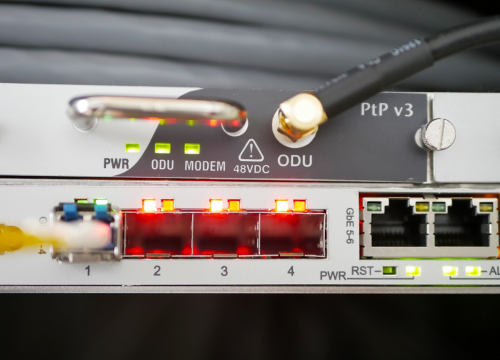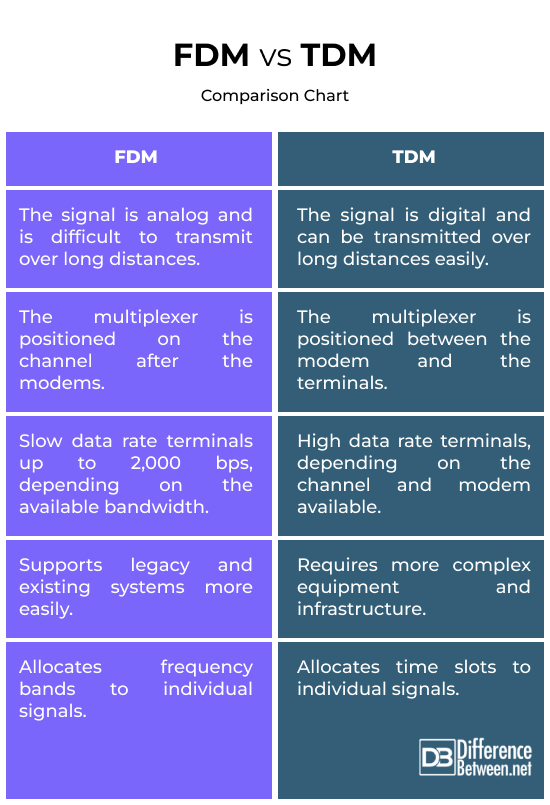Difference Between FDM and TDM
FDM and TDM are both types of multiplexing techniques that are utilized in order to transmit many signals simultaneously over a single channel. TDM equipment has steadily caught up to FDM technology in terms of its transmission quality, which has allowed TDM equipment to gradually catch up to FDM equipment in terms of affordability. In spite of the fact that both approaches are effective in sharing communication channels, there are significant distinctions between the two procedures.
The following is a discussion of the primary distinctions that exist between FDM and TDM.

What is FDM?
Transmission of numerous signals across a single communication channel is accomplished by the use of a technique known as frequency division multiplexing, or FDM for short. In frequency division multiplexing (FDM), the available frequency spectrum is segmented into various frequency bands, and to facilitate transmission, each signal is given its own distinct band. Because of this, it is possible for many signals to coexist without causing interference with one another.
Every user is guaranteed to receive a portion of the available frequency spectrum, and FDM channels operate in parallel with one another. In order to reduce the likelihood of interference across frequency broadcasts, guard bands split users into distinct groups. Different communication technologies, such as radio broadcasting and wired communication, frequently make use of frequency division multiplexing (FDM).

What is TDM?
Time Division Multiplexing, more commonly referred to as TDM, is a technique that allows for the transmission and reception of numerous signals over a single communication channel. In order to ensure that each signal receives its own time slot for broadcast, the available time on the channel is segmented into discrete time slots. Because of this design, every signal will have the opportunity to be broadcast in its own right. Because of this, it is possible for many signals to share the same channel without causing conflict.
As a result of the signal being in digital form, transmission across vast distances is made more simpler in time division multiplexing (TDM). Several different communication systems, such as digital telephone networks, make extensive use of time division multiplexing (TDM) in order to maximize the usage of time and transmit a variety of data streams in an effective manner.
Difference between FDM and TDM
Signal Type
With analog transmissions, where the variable amplitude or frequency of the signal carries information, frequency division multiplexing (FDM) is the most common use. Applications such as classic radio transmission, in which continuous analog signals are sent concurrently, are some of the applications that fit this description.
Digital signals, in which information is represented in a discrete, binary form (0s and 1s), are the primary application for time division multiplexing (TDM). In situations when information is essentially in digital format and needs to be transmitted sequentially in time slots, it is frequently applied in digital communication systems. One example of such a system is the digital telephone network.
Principle of Division
In FDM, the available frequency spectrum is divided into distinct frequency bands, and each signal is assigned a unique band for transmission. This allows multiple signals to coexist without interfering with each other.
In TDM, the available time on the channel is divided into discrete time slots, and each signal is allocated its own time slot for transmission. This sequential arrangement ensures that each signal gets its turn to be transmitted.
Position of the Multiplexer
In FDM, modems are placed at the end of the communication link, before the multiplexer, which combines multiple analog signals into a composite signal that is then transmitted over the communication channel.
In TDM, the multiplexer is positioned between the modem and the terminals. The multiplexer takes digital signals from various sources and allocates them time slots for sequential transmission over the communication channel.
Interference Handling
In FDM, signals are separated by distinct frequency bands, which minimizes the likelihood of interference between them.
In TDM, signals are transmitted sequentially in designated time slots to avoid interference by ensuring only one signal is active at a given moment.
Application
FDM is commonly used in radio broadcasting, wired communication, and applications where signals can be transmitted simultaneously at different frequencies.
TDM is widely used in digital telephone networks and scenarios where signals can be sequentially transmitted without the need for simultaneous transmission.
FDM vs. TDM: Comparison Chart

Summary
In situations when you are dealing with terminals that have varying requirements for the data rate, FDM provides you with greater freedom, whereas TDM guarantees that each terminal receives equal and defined time intervals. In the event that you have terminals with a sluggish data rate (up to 2,000 bps), FDM is the method that you should use. On the other hand, TDM excels when high data rate terminals are grouped together.
FAQs
Why is TDM more efficient than FDM?
TDM utilizes the entire available bandwidth by slicing time into slots for different signals, leaving no gaps. FDM, on the other hand, divides the frequency spectrum into channels, resulting in unused gaps between them.
What is the difference between time-division and frequency-division?
Time-division multiplexing (TDM) allocates time slots to different signals for sequential transmission, while frequency-division multiplexing (FDM) assigns distinct frequency bands to different signals, enabling simultaneous transmission.
What is the difference between WDM and FDM?
Both divide the electromagnetic spectrum for simultaneous transmission, but WDM uses light and FDM uses radio waves. WDM’s narrower channels make it suitable for high-capacity data transfers, while FDM has a long-standing legacy in radio and TV broadcasting..
Is FDM faster than TDM?
No, FDM is intended for slow data rate terminals up to 2,000 bps.
What are the disadvantages of TDM?
TDM might stumble when dealing with wildly different data rates, and synchronization issues can crop up if you don’t keep those time slots in check.
What are the disadvantages of FDM?
FDM could leave some gaps between frequency channels, leading to less efficient bandwidth use. Plus, watch out for interference between neighboring frequency bands.
What are the advantages of FDM?
- FDM allows for the simultaneous transmission of multiple signals.
- It’s the go-to for radio broadcasting, letting different stations share the frequency spectrum.
- Difference Between Caucus and Primary - June 18, 2024
- Difference Between PPO and POS - May 30, 2024
- Difference Between RFID and NFC - May 28, 2024
Search DifferenceBetween.net :
21 Comments
Leave a Response
References :
[0]Image credit: https://www.canva.com/photos/MAC_4i550gw-telecommunication-multiplexer/
[1]Image credit: https://www.canva.com/photos/MADFRH7-wPE-the-multiplexer-support-internet/
[2]Otung, Ifiok. Communication Engineering Principles. John Wiley & Sons, 2021.
[3]Ryan, Michael J. and Michael Frater. Communications and Information Systems. Argos Press P/L, 2002.

This article is really excellent and has solved all my problems, Thanx to difference between dot net.
thanks a lot .Really amazing,bravo…………. Keep it up
This article was very helpful to complete my assignment and queries. Thanks you…. .
This article is brilliant in explaining what they are and their differences in an understandable manner! Thankyou!
its very explainable. thank u
thanks a ton !!! going to use this on my paper,,,,
i love this websites
i love this web site……thanks to all of this…..many problem solve this..
thanks all
The Primary difference between FDM and TDM is how they divide the channel. FDM divides a channel into two or more frequencies range that do not overlap while TDM divides and allocates certain time periods to each channel in an alternating manner. Due to this facet, we can say that for TDM, each signal uses all of the bandwidth, while FDM each signal uses a small portion of the bandwidth all of the time
Thanx
This article is good enough to explain FDM & TDM.
I would request to explain QPSK, QAM-16, QAM-64, QAM-256 and differentiate each other, and what is basic requirement of it?
Thank you very much.
Excellent, precise and beautiful !!
“Time-division multiplexinig telecommunications for telegraphy systems in the late 19th century, but found its most common application in digital telephony in the second half of the 20th century.”
http://multiplexingandmultipleaccess.blogspot.in/2014/07/difference-in-between-tdm-and-fdm.html
Thxxxxxxxxxx
Nice it is very help full for me thanks sir you save my 10 maks may be more then it
Very helpful and easy to understand.. thank u
thanks for sharing
It’s simple language is my problem solved
I like these explanation really, helpful. Thank you.
Very super
this article was really helpfull.
thank you brother.
may u live long